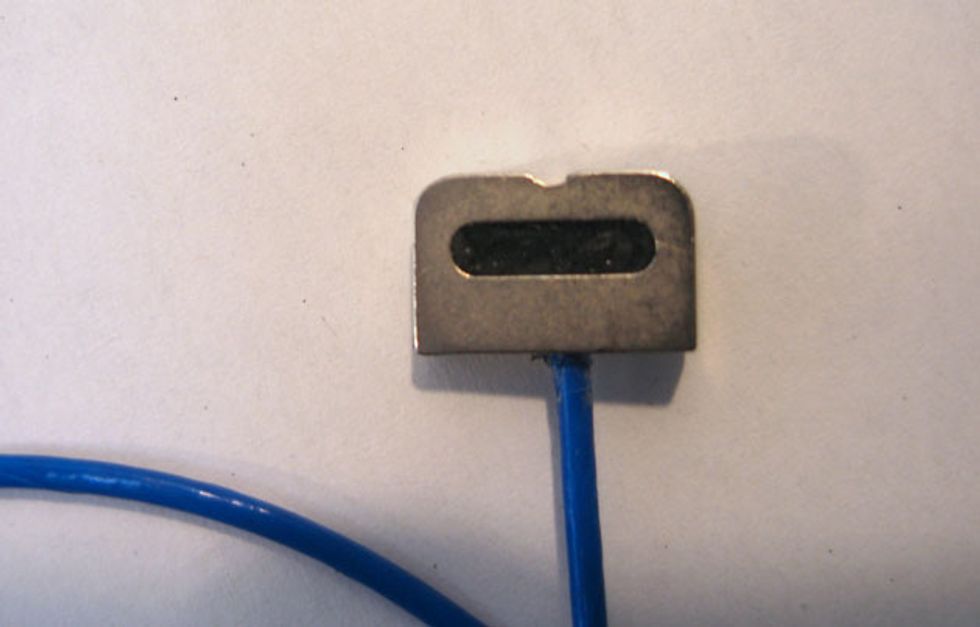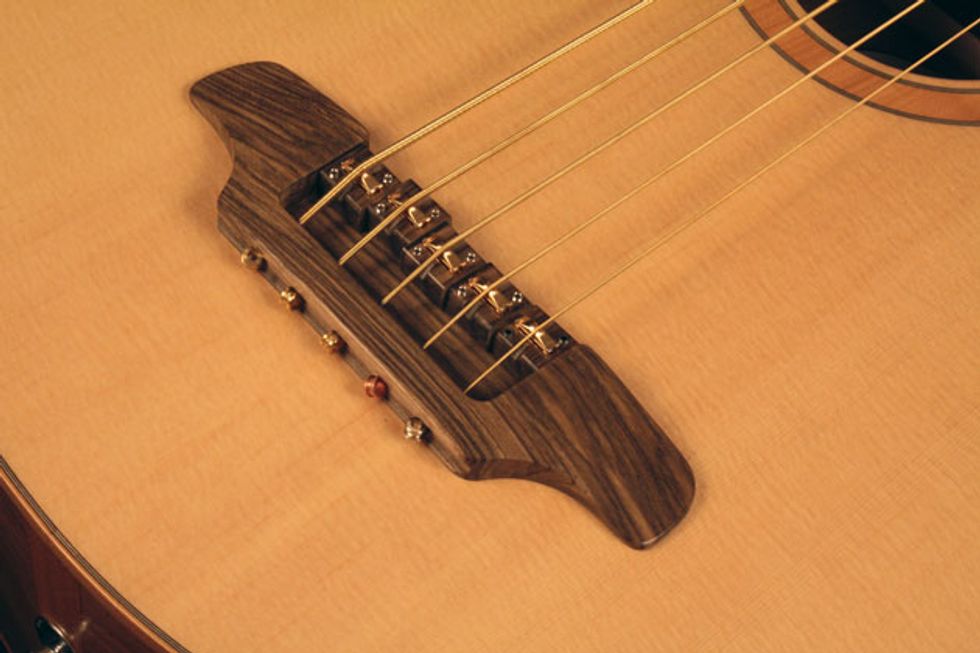Photo 1. Photo courtesy of basslab.de.
When we previously surveyed several different types of pickups for acoustic bass guitar [“Amplifying an Acoustic Bass Guitar”], we gave the popular under-saddle transducer some extra attention. Let’s continue this line of thought and see what else we can do with a piezo.
Not all under-saddle piezo pickups are the same. If you’re unhappy with how yours sounds, you might consider seeking a replacement. But before you spend cash on a new one, it’s a good idea to check whether yours is set up properly. This can involve removing dirt from the saddle slot, making sure the piezo has enough space within its slot, adjusting the strings’ break angle over the saddle, and defeating hum. Numerous installation and trouble-shooting guides on the web cover these common issues.
While the number of piezo products isn’t as huge as with magnetic pickups, it’s still tough to choose the right one. Although the piezo material itself doesn’t vary much, there are quality differences between devices. For example, some piezos are wrapped in simple heat-shrink tubing, while others have hard, thin conductive coatings.
Here are some oft-mentioned disadvantages of under-saddle piezos:
• Unbalanced string volume. This can occur easily, and it often takes a long time to correct.
• When the piezo is under high pressure (or rather, intense contact), the resulting tones can be harsh, unnaturally direct, and overly percussive.
• Piezos detect the movement of the string—not the soundboard—which can result in unnatural tones.
Some of these critiques are irrefutable, while those involving tone quality are subjective. At any rate, you can’t judge quality by price alone. (For example, the heat-shrink tubing on a cheap model might soften those harsh, percussive qualities.)
One obvious solution is to change the piezo’s position, moving it from under the saddle to the soundboard. On a bass with acoustically balanced strings, this guarantees equal string volume. (And once mounted inside the body, the piezo is as invisible as an under-saddle pickup.)
Speaking of volume: Without direct string contact, soundboard transducers tend to output lower levels, partly because of the softer initial attack. Some manufacturers compensate for this with preamps, or by employing two or more transducers. These soundboard transducers should be mounted either directly under the bridge, or in areas that vibrate as much and as freely as possible, so stay away from structurally “dead” bracing areas. Experimenting with positions can be time-consuming, but it’s not as annoying as trying to balance string volume by sanding an under-saddle piezo.
Because the soundboard is the natural source of acoustic tone, the soundboard solution would seem to be a clear winner, right? Not so fast: It’s a bit shortsighted to claim that under-saddle transducers don’t take the soundboard into account. The piezo is a pressure sensor, so if you move the saddle’s base (the soundboard), the pickup will surely pick up the difference signal, not just the string above. Also, if you glue a pressure sensor to the soundboard, it will move along with the soundboard. Can you then expect it to provide the full sonic picture?
There’s a third option—let’s call it “mid-saddle.” Here, the piezo is a fixed part of the saddle itself.This approach keeps some string pressure off the pickup element, which can reduce the unnaturally percussive attack of under-saddle construction.
Photo 2. Photo courtesy of chrislarkinguitars.com.
Instead of using a single piezo element that extends the entire saddle length to simultaneously pick up all strings, mid-saddle systems comprise a set of single-string pickups. Check it out: Photo 1 shows an ETS single-string saddle with an embedded piezo. In this type of design, each single-string piezo is glued into the saddle or embedded in resin, and this protects the electrical and mechanical contacts. Still a rarity on acoustic bass guitars, the fully adjustable bridge (Photo 2) on this Chris Larkin instrument contains five RMC single-string pickups.
Ah, but we’re not done yet. If you wire a set of single-string pickups in parallel and send the combined signal into one preamp, you can only hope the manufacturer has carefully preselected the pickups for even volume, as there’s no way to alter each pickup’s volume on your own. To avoid such problems, you can go the more expensive route of sending each string’s signal to a separate, adjustable preamp. Of course, once you have single-string outputs, there’s also the option to use MIDI.
And as if this weren’t already complicated enough, there are many solutions that combine various approaches we’ve been discussing. And we haven’t even talked about microphones yet—though we will soon.









![Rig Rundown: AFI [2025]](https://www.premierguitar.com/media-library/youtube.jpg?id=62064741&width=1245&height=700&quality=70&coordinates=0%2C0%2C0%2C0)












 Shop Scott's Rig
Shop Scott's Rig















































